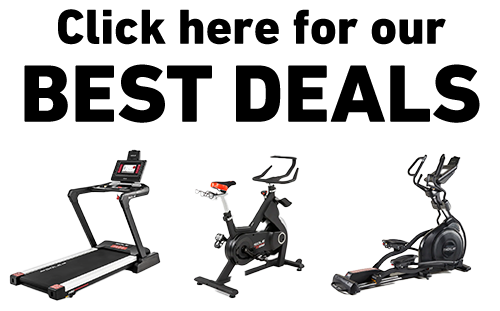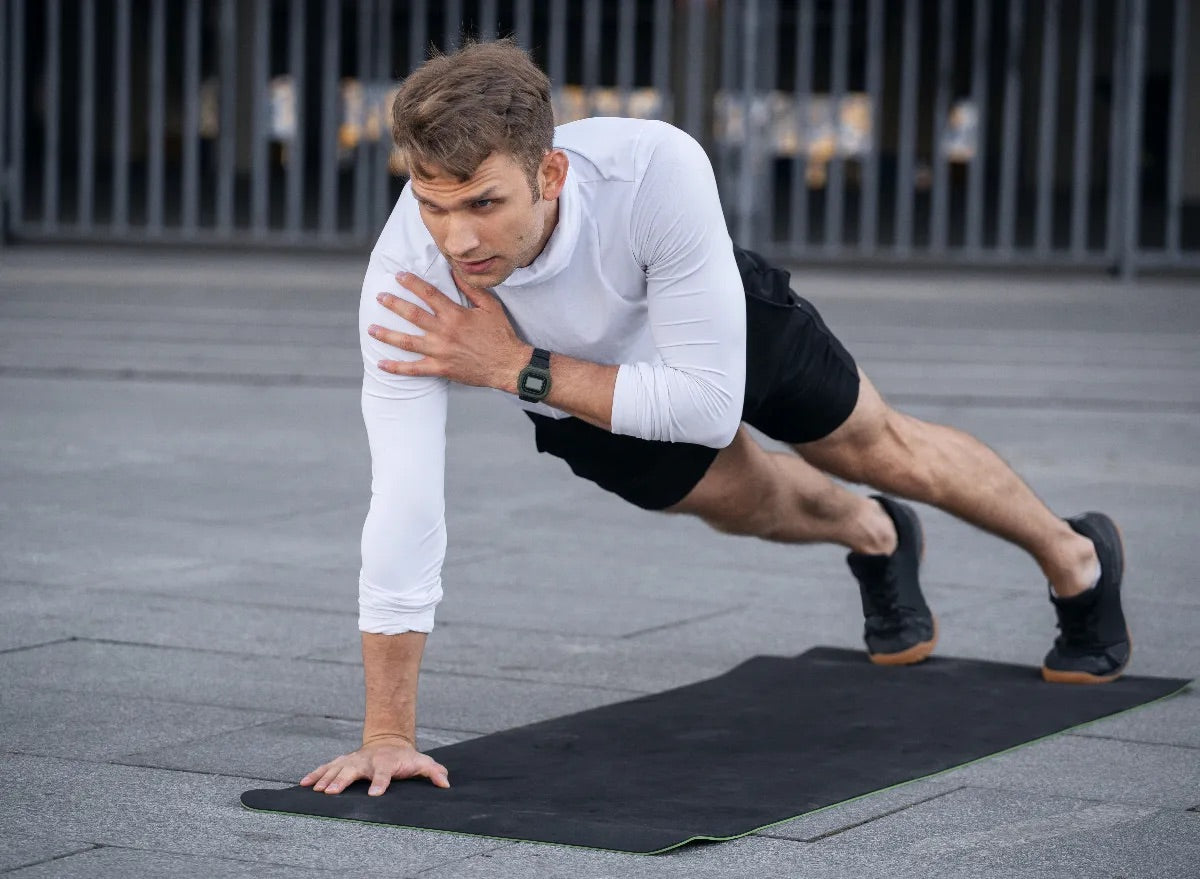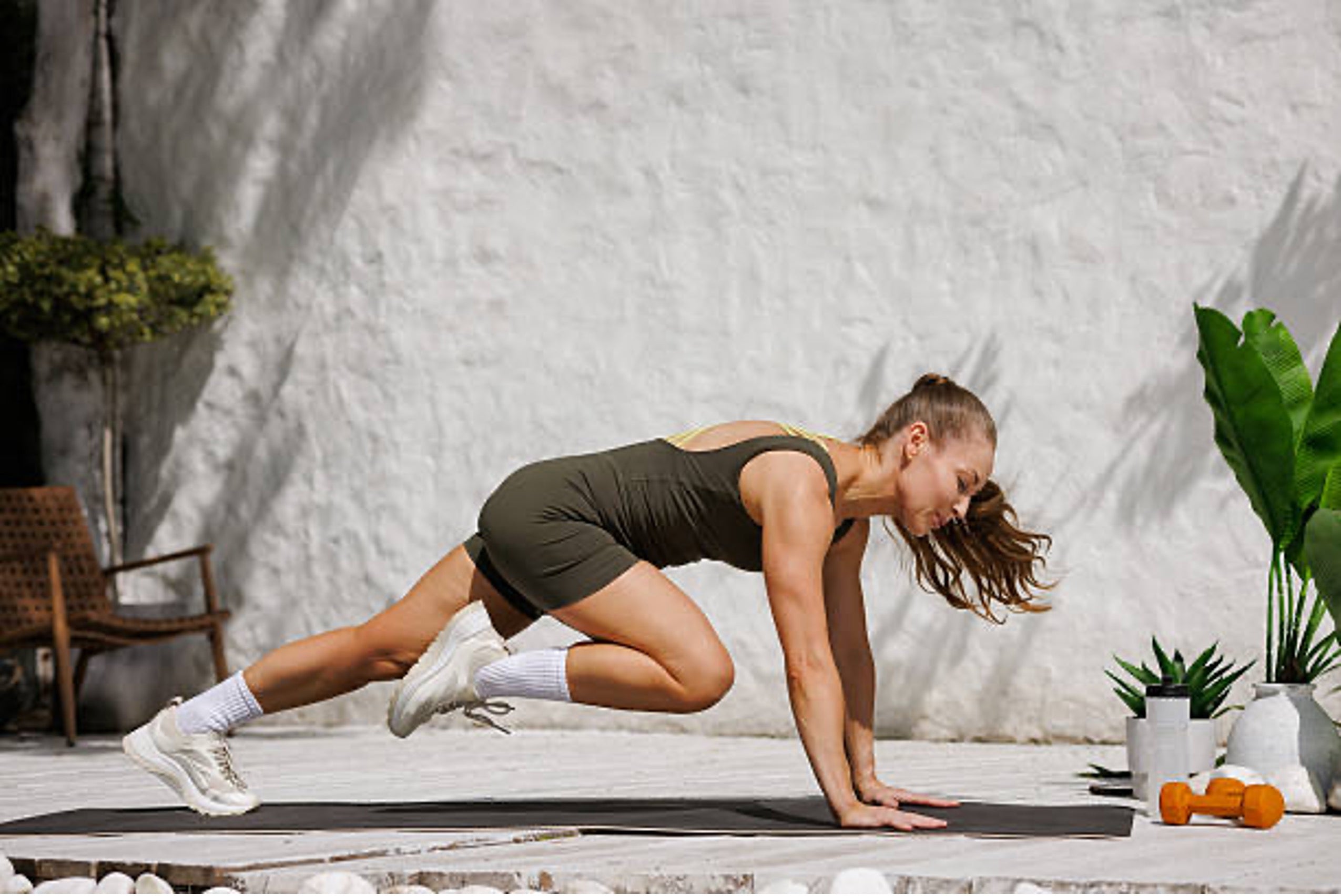Key Takeaways
- Modified burpees and low-impact alternatives provide the same full-body conditioning benefits without the joint stress of traditional burpees.
- Mountain climbers and plank shoulder taps offer excellent core engagement while being more accessible for fitness beginners.
- Progression-focused alternatives like step-back burpees allow beginners to build strength and confidence before attempting standard burpees.
- Kettlebell swings and jump squats can help develop the explosive power needed for burpees while being easier to master.
- Quality equipment from trusted brands like SOLE Fitness can enhance your home workout experience, offering the stability and durability needed for these dynamic movements.
Why You Need Burpees Alternatives
Traditional burpees combine a squat, plank, push-up, and jump into one continuous movement that challenges even experienced fitness enthusiasts.
For beginners, this compound exercise presents several significant barriers. The rapid transitions between positions require considerable core strength, upper body power, and cardiovascular endurance that most beginners haven't yet developed.
Without proper form, which is difficult to maintain when you're new to exercise, you risk injury rather than improvement. What's more, burpees demand a level of coordination and body awareness that typically comes only after consistent training.
Starting with more accessible alternatives allows you to build the specific strength and mobility components needed for burpees in a progressive, confidence-building way. These alternatives isolate the individual movement patterns, letting you master each element before combining them into more complex exercises.
|
Premium Home Gym Equipment with Award-Winning Quality!
Why Choose SOLE: ✓ Commercial-grade quality for home use 30-Day Money-Back Guarantee: Love it or return it, no questions asked. |
7 Beginner-Friendly Alternatives to Master Before Trying Burpees
1. Modified Step-Back Burpees
Modified Step-Back burpees removes the explosive jumping and push-up components that make traditional burpees so challenging.
Start standing with feet shoulder-width apart. Bend your knees into a squat position, placing your hands on the floor. Instead of jumping your feet back, step one leg back at a time into a plank position. Hold briefly, then step your feet forward one at a time back to the squat position.
Stand up tall to complete one rep. This modification significantly reduces impact while teaching proper burpee sequencing and building coordination.
2. Mountain Climbers for Full-Body Conditioning
Mountain climbers deliver much of the cardiovascular benefit of burpees while building core strength and shoulder stability.
To start this exercise, begin in a plank position with your hands directly under your shoulders and body forming a straight line. Keeping your core tight, bring one knee toward your chest, then quickly switch legs in a running motion.
Start with 20–30 seconds of slow, controlled movements before attempting faster speeds. The beauty of mountain climbers is how they simultaneously strengthen your upper body while elevating your heart rate—just like burpees, but with less technical demand.
3. Squat to Stand for Lower Body Power
Squat to stands build lower body power while improving hip mobility, two essential components of the burpee movement pattern. Start with feet shoulder-width apart.
Lower into a deep squat position and place your hands on the floor between your feet. Keeping your hands on the floor, straighten your legs as much as possible while lifting your hips high (similar to a deadlift position).
Bend your knees to return to the squat position, then stand tall. This exercise teaches proper squat mechanics while building hamstring and glute strength needed for the explosive elements of burpees.
4. Plank Shoulder Taps for Core Stability
Core stability is crucial for proper burpee execution, and plank shoulder taps target this directly.
Begin in a high plank position with hands under shoulders and feet hip-width apart. Keeping your hips square to the floor (imagine balancing a cup of water on your lower back), lift one hand and tap the opposite shoulder.
Return to plank and repeat with the other hand. The key is preventing your hips from rotating or sagging, which engages the same core stabilizers needed during burpees.
Start with sets of 10–12 taps per side, focusing on stability rather than speed. As you progress, you can increase the challenge by widening your foot stance or performing the movement more quickly while maintaining proper form.
5. Jump Squats for Explosive Power
Jump squats isolate the explosive lower body component of burpees, building power and conditioning your cardiovascular system. Stand with feet shoulder-width apart, lower into a squat position with weight in your heels and chest lifted.
Push through your heels to jump upward, extending fully through your hips. Land softly by bending your knees and immediately lowering back into the squat position.
For those with knee concerns, start with smaller jumps or even practice squat to calf raises until you build more strength.
6. Push-Up to Squat Transitions
This exercise bridges the gap between modified burpees and the real thing by practicing the transition from floor to standing position. Begin in a push-up position with hands under shoulders.
Perform one push-up (modified from knees if needed), then jump or step both feet forward outside your hands, landing in a deep squat position. Stand up tall, then place your hands back on the floor and jump or step back to the push-up position to begin the next rep.
The push-up to squat transition teaches your body the coordination needed for the floor-to-standing portion of burpees, which many beginners find particularly challenging.
7. Kettlebell Swings for Hip Strength
Kettlebell swings develop explosive hip power—the exact same driving force behind burpees' standing jump.
Start with feet slightly wider than shoulder-width apart and a kettlebell on the floor between your feet. Hinge at the hips (not squat) to grasp the kettlebell with both hands.
With a flat back and engaged core, thrust your hips forward powerfully to swing the kettlebell to chest height. As the kettlebell descends, hinge at the hips again, allowing it to swing back between your legs before repeating the movement.
For beginners, start with a lighter kettlebell (8–12 kg for women, 12–16 kg for men) and focus on the hip hinge motion rather than using your arms to lift the weight. The power should come entirely from your hip extension.
This exercise builds the posterior chain strength needed for burpees and teaches the explosive hip drive that makes the standing jump portion of burpees possible.
Building Your Fitness Foundation with SOLE
At SOLE Fitness, we understand that every fitness journey begins with a single step, and that step doesn't have to be a burpee. Just as our treadmills, ellipticals, and strength equipment are engineered to support your fitness journey for years to come, these alternative exercises create the groundwork for long-term success.
Your fitness journey deserves more than compromise solutions. It deserves the complete SOLE experience.
No matter if you're performing mountain climbers on one of our commercial-grade treadmill decks, using our strength equipment to add resistance to squat movements, or following along with the hundreds of bodyweight routines available on our SOLE+ app, we're committed to meeting you exactly where you are in your fitness journey.
The best workout equipment, like the best exercises, is what you'll actually use consistently. That's why we offer a 30-day trial period on all equipment purchases; we believe fitness should enhance your life, not complicate it.
Your fitness journey is a marathon, not a sprint. Check out our equipment today!
Frequently Asked Questions
What equipment do I need to perform these burpee alternatives at home?
Most alternatives require minimal equipment, just your body weight and floor space. However, kettlebell swings need a quality kettlebell (8–16 kg), and some modifications work better with exercise mats for joint comfort. Push-up handles or parallettes can also reduce wrist strain during plank-based movements.
How do I know when I'm ready to progress from alternatives to actual burpees?
You're ready when you can complete 15–20 jump squats with perfect form, hold a plank for 60+ seconds, and perform 12–15 push-ups to squat transitions without compromising technique. This typically takes 6–12 weeks of consistent practice, depending on your starting fitness level.
Should I do these alternatives every day or follow a specific schedule?
Aim for 2–3 sessions per week with at least one rest day between workouts. This allows proper recovery while maintaining consistency. You can alternate between different alternatives each session or create circuits combining 3–4 exercises for comprehensive full-body conditioning.
What's the biggest mistake beginners make with these alternatives?
Rushing through repetitions instead of focusing on proper form. Many beginners try to match the speed they see in fitness videos without first mastering the movement patterns. Start slowly, prioritize technique over speed, and gradually increase intensity as your coordination and strength improve.
Can I use SOLE Fitness equipment to enhance these alternative exercises?
Absolutely! SOLE Fitness’s sturdy equipment provides excellent surfaces for plank variations and mountain climbers, while their strength equipment can add resistance to squat movements. The free SOLE+ app also offers guided bodyweight workouts that incorporate many of these alternative exercises with professional instruction.







Leave a comment
This site is protected by hCaptcha and the hCaptcha Privacy Policy and Terms of Service apply.